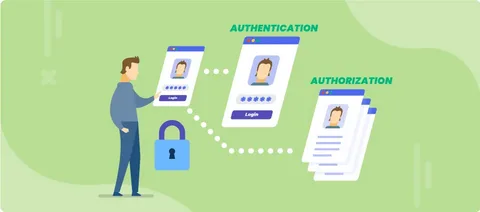In the digital age, securing web applications is a top priority. Authentication and authorization are the two cornerstones of this effort, ensuring that users are who they claim to be and have access to only the resources they are permitted to use. If you’re a developer wondering how to integrate these mechanisms into your web app, this guide is for you.
What is Authentication?
Authentication is the process of verifying a user’s identity. It ensures that users provide valid credentials, such as a username and password, to access a web app.

Common Authentication Methods
- Password-Based Authentication: Traditional username and password combinations.
- Multi-Factor Authentication (MFA): Adds an extra layer, like a one-time password (OTP).
- OAuth: Used for third-party logins (e.g., “Sign in with Google”).
- Biometric Authentication: Uses fingerprints or facial recognition.
What is Authorization?
Authorization determines what a user can access within the web app after authentication. For instance, a standard user might not have access to admin functionalities.
Types of Authorization Models
- Role-Based Access Control (RBAC): Users are assigned roles, and roles determine access.
- Attribute-Based Access Control (ABAC): Access is granted based on attributes like user location or time of access.
Key Differences Between Authentication and Authorization
| Aspect | Authentication | Authorization |
|---|---|---|
| Purpose | Verify user identity. | Control user access. |
| Occurs When? | At the login stage. | After login. |
| Example | Checking password correctness. | Determining access to admin page. |
Steps to Implement Authentication in a Web App
1. Choose an Authentication Strategy
Select a method that suits your app’s needs: passwords, OAuth, or token-based approaches like JSON Web Tokens (JWT).
2. Use a Secure Password Storage Method
- Hash passwords using strong algorithms like bcrypt.
- Avoid storing plain-text passwords in your database.
3. Set Up a Login Mechanism
Build a form where users can input their credentials and validate them against the database.
4. Implement Session Management
- Use cookies or session storage to track logged-in users.
- Ensure cookies are secure and have the
HttpOnlyandSecureflags enabled.
5. Integrate Third-Party Logins (Optional)
To streamline the login process, add services like Google, Facebook, or GitHub authentication using OAuth 2.0.
6. Protect Against Brute Force Attacks
- Limit login attempts.
- Use CAPTCHAs after multiple failed attempts.
Steps to Implement Authorization in a Web App
1. Define Roles and Permissions
Create a list of roles (e.g., user, admin) and map them to specific actions or resources in your application.
2. Build Access Control Logic
- Use middleware to check permissions.
- Example in Node.js:
javascriptCopy codefunction isAdmin(req, res, next) {
if (req.user && req.user.role === 'admin') {
return next();
}
res.status(403).send('Access Denied');
}
3. Protect Sensitive Routes
Apply authorization logic to routes requiring restricted access.
4. Validate Token Expiry
If using JWTs, ensure that expired tokens are not accepted by verifying their validity on each request.
Popular Libraries and Tools for Authentication and Authorization
1. Passport.js
- What it does: A Node.js middleware for authentication.
- Use case: Local, OAuth, or custom authentication strategies.
2. Firebase Authentication
- What it does: Provides an easy-to-integrate authentication system.
- Use case: Web apps, mobile apps.
3. JSON Web Tokens (JWT)
- What it does: Enables token-based authentication and session management.
- Use case: Stateless authentication.
4. Okta and Auth0
- What it does: Offers third-party identity and access management.
- Use case: Enterprises needing secure, scalable authentication systems.
5. Django Rest Framework (DRF) Authentication
- What it does: Provides built-in support for authentication in Django apps.
Security Best Practices for Authentication and Authorization
1. Use HTTPS
Always encrypt communications between the client and server using HTTPS.
2. Implement MFA
Add a second layer of security to reduce the risk of unauthorized access.
3. Regularly Rotate Secrets
Change API keys, passwords, and other secrets periodically to minimize security risks.
4. Protect Against CSRF and XSS Attacks
- Use CSRF tokens for sensitive actions.
- Sanitize user input to prevent cross-site scripting (XSS).
5. Keep Dependencies Updated
Ensure you’re using the latest versions of libraries and frameworks to patch vulnerabilities.
Common Challenges in Authentication and Authorization
1. Managing User Roles
Complex applications can have overlapping roles, making it challenging to implement robust RBAC.
2. Token Expiry and Revocation
Managing token expiry and handling revocation for compromised tokens can be tricky.
3. Scalability
As the user base grows, ensuring authentication and authorization systems scale becomes critical.
Conclusion
Implementing authentication and authorization in web apps is essential for protecting user data and application resources. While it can seem daunting, using modern tools and following best practices can simplify the process. Start small, build securely, and ensure you continuously update and refine your security mechanisms as your application grows.